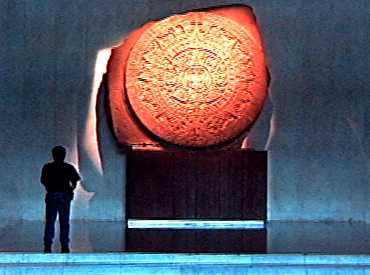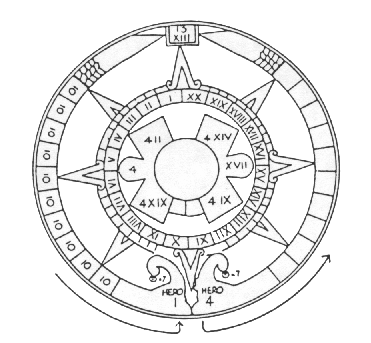 |
|
Photograph by Richard Olsenius © 1996 National Geographic Society. All rights reserved.
|
 |
|
Photograph by Richard Olsenius © 1996 National Geographic Society. All rights reserved.
|
The so-called Aztec calendar sunstone is a thirteen-and-a-half feet, once polychromed [Sieck] basalt relief weighing twenty-five tons, a visual representation of the Mexica creation myth with an image of the Mesoamerican conception of cyclical time and space.
It provides an image of the Mesoamerican view of the equivalence of space and time in its depiction of the four suns surrounding the Fifth sun at the center, and in this way can be considered a calendar that represents larger time spans, the world ages or eras.
The face portrayed at the center of the stone is generally interpreted as the Mexica sun god, Tonatiuh, symbolizing the Fifth Sun, the sun of Motion (4-Movement, or Nahui-Ollin). The four quadrants spaced around the central figure represent the preceding four suns, or eras, and each contains a representation of the name of the particular era derived from the sign of its last day, a name that indicates as well the way of its destruction. The first, on the upper right, designates the first Sun, 4-Jaguar, followed in counterclockwise order by the second Sun, 4-Wind; the third sun, 4-Rain; and the fourth sun, 4-Water.
The ring encircling all this contains the glyphs of each of the twenty day signs of the tonalpohualli, the 260-day sacred calendar, also in counterclockwise order.

The second ring before the outermost one consists of 52 segments, the number of years in the calendar Round, the xiuhmolpilli or year bundling, whose beginning was marked by the New Fire ceremony.
The outer rim is formed by two fire serpents, Xiuhcoatls, whose tails come together at the top of the stone, while their heads, from whose open mouths emerge two anthropomorphic heads, meet at the bottom. Each serpent consists of 10 segments with the number 10 along with the New Fire glyph in each one for a total of 10X10=100 calendar rounds or 100X52=5200 years.
At the top of the stone stands the calendrical name 13-Reed, which is related to the contemporary Mexica date of 1479; but it also corresponds nominally to the year 3113 BCE, a possible marker for the beginning of the current era 4-Movement, and including 5200 years, the fifth in the schemes of Suns and a fifth of the precessional cycle of the earth of 26,000 years.
In general, the uses and meaning of the sunstone is ignored and a completely agreed-upon interpretation has not been reached for this magnific monument.